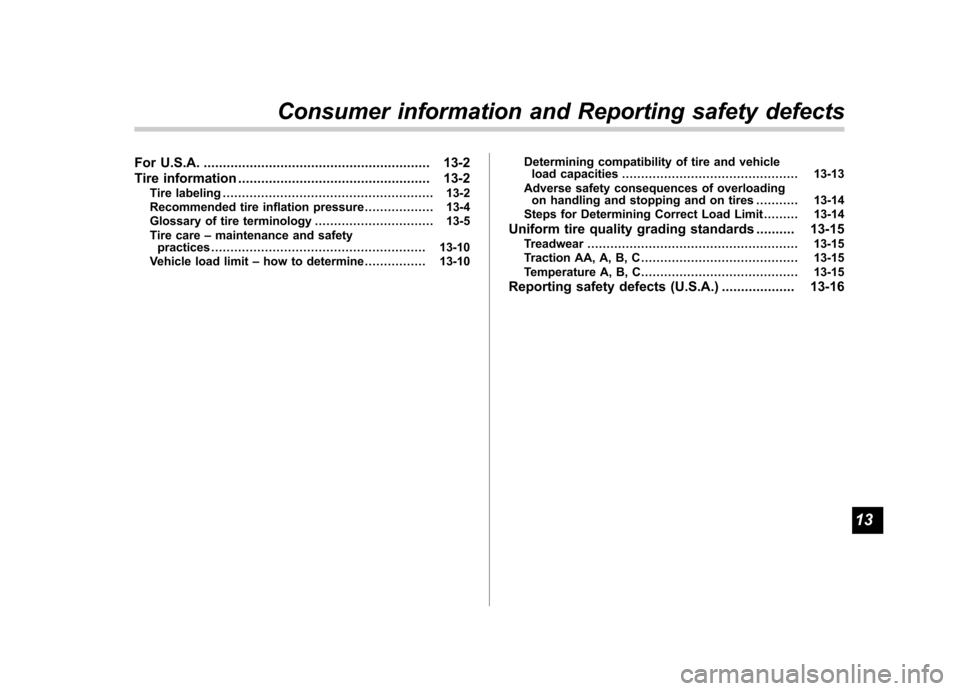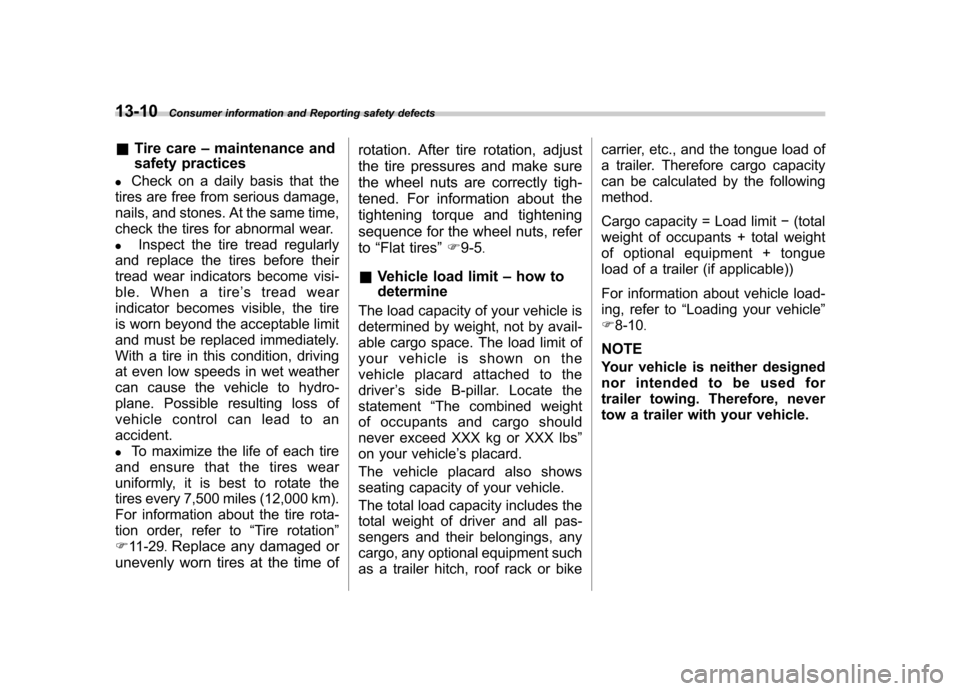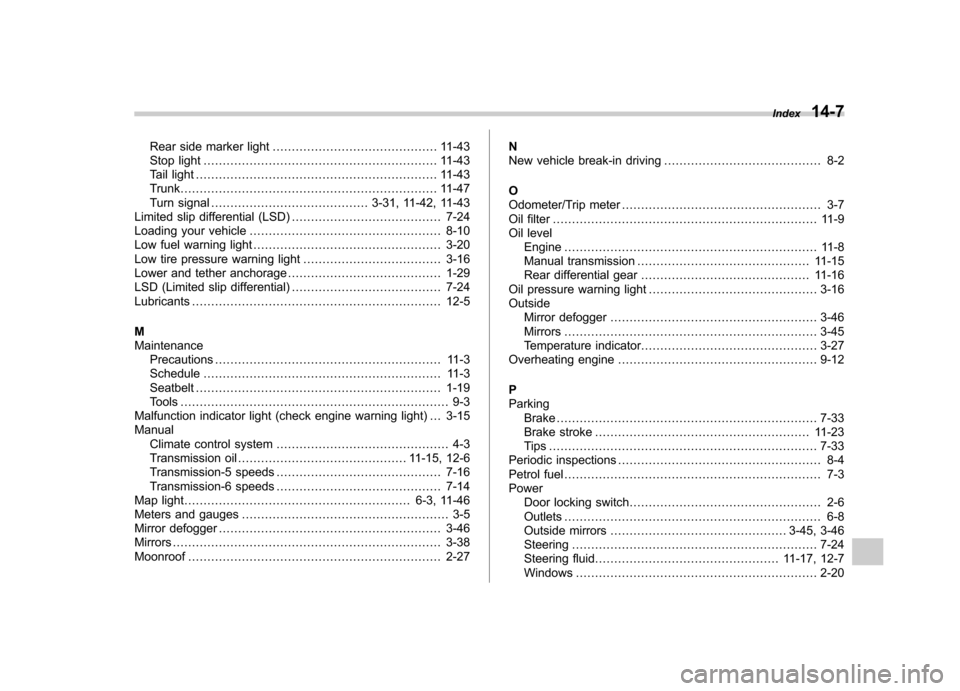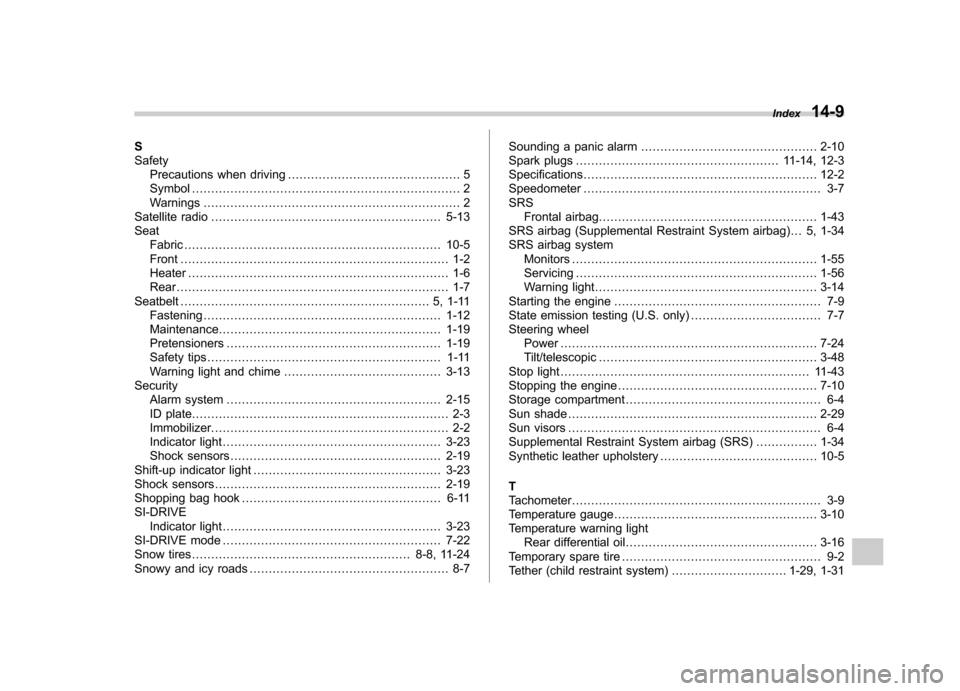2013 SUBARU IMPREZA WRX maintenance
[x] Cancel search: maintenancePage 386 of 414

For U.S.A............................................................ 13-2
Tire information .................................................. 13-2
Tire labeling ....................................................... 13-2
Recommended tire inflation pressure .................. 13-4
Glossary of tire terminology ............................... 13-5
Tire care –maintenance and safety
practices ........................................................ 13-10
Vehicle load limit –how to determine ................ 13-10 Determining compatibility of tire and vehicle
load capacities .............................................. 13-13
Adverse safety consequences of overloading on handling and stopping and on tires ........... 13-14
Steps for Determining Correct Load Limit ......... 13-14
Uniform tire quality grading standards .......... 13-15
Treadwear ....................................................... 13-15
Traction AA, A, B, C ......................................... 13-15
Temperature A, B, C ......................................... 13-15
Reporting safety defects (U.S.A.) ................... 13-16
Consumer information and Reporting safety defects
13
Page 395 of 414

13-10Consumer information and Reporting safety defects
& Tire care –maintenance and
safety practices
. Check on a daily basis that the
tires are free from serious damage,
nails, and stones. At the same time,
check the tires for abnormal wear. . Inspect the tire tread regularly
and replace the tires before their
tread wear indicators become visi-
ble. When a tire ’streadwear
indicator becomes visible, the tire
is worn beyond the acceptable limit
and must be replaced immediately.
With a tire in this condition, driving
at even low speeds in wet weather
can cause the vehicle to hydro-
plane. Possible resulting loss of
vehiclecontrolcanleadtoanaccident. . To maximize the life of each tire
and ensure that the tires wear
uniformly, it is best to rotate the
tires every 7,500 miles (12,000 km).
For information about the tire rota-
tion order, refer to “Tire rotation ”
F 11-29 .
Replace any damaged or
unevenly worn tires at the time of rotation. After tire rotation, adjust
the tire pressures and make sure
the wheel nuts are correctly tigh-
tened. For information about the
tightening torque and tightening
sequence for the wheel nuts, refer to
“Flat tires ”F 9-5 .
& Vehicle load limit –how to
determine
The load capacity of your vehicle is
determined by weight, not by avail-
able cargo space. The load limit of
your vehicle is shown on the
vehicle placard attached to the
driver ’s side B-pillar. Locate the
statement “The combined weight
of occupants and cargo should
never exceed XXX kg or XXX lbs ”
on your vehicle ’s placard.
Thevehicleplacardalsoshows
seating capacity of your vehicle.
The total load capacity includes the
total weight of driver and all pas-
sengers and their belongings, any
cargo, any optional equipment such
as a trailer hitch, roof rack or bike carrier, etc., and the tongue load of
a trailer. Therefore cargo capacity
can be calculated by the following method.
Cargo capacity = Load limit
�(total
weight of occupants + total weight
of optional equipment + tongue
load of a trailer (if applicable))
For information about vehicle load-
ing, refer to “Loading your vehicle ”
F 8-10 .
NOTE
Your vehicle is neither designed
nor intended to be used for
trailer towing. Therefore, never
tow a trailer with your vehicle.
Page 408 of 414

Rear side marker light........................................... 11-43
Stop light ............................................................. 11-43
Tail light ............................................................... 11-43
Trunk ................................................................... 11-47
Turn signal ......................................... 3-31, 11-42, 11-43
Limited slip differential (LSD) ....................................... 7-24
Loading your vehicle .................................................. 8-10
Low fuel warning light ................................................. 3-20
Low tire pressure warning light .................................... 3-16
Lower and tether anchorage ........................................ 1-29
LSD (Limited slip differential) ....................................... 7-24
Lubricants ................................................................. 12-5
M Maintenance Precautions ........................................................... 11-3
Schedule .............................................................. 11-3
Seatbelt ................................................................ 1-19
Tools ...................................................................... 9-3
Malfunction indicator light (check engine warning light) ... 3-15Manual Climate control system ............................................. 4-3
Transmission oil ............................................ 11-15, 12-6
Transmission-5 speeds ........................................... 7-16
Transmission-6 speeds ........................................... 7-14
Map light ........................................................... 6-3, 11-46
Meters and gauges ...................................................... 3-5
Mirror defogger .......................................................... 3-46
Mirrors ...................................................................... 3-38
Moonroof .................................................................. 2-27 N
New vehicle break-in driving
......................................... 8-2
O
Odometer/Trip meter .................................................... 3-7
Oil filter ..................................................................... 11-9
Oil level Engine .................................................................. 11-8
Manual transmission ............................................. 11-15
Rear differential gear ............................................ 11-16
Oil pressure warning light ............................................ 3-16
Outside Mirror defogger ...................................................... 3-46
Mirrors .................................................................. 3-45
Temperature indicator .............................................. 3-27
Overheating engine .................................................... 9-12
PParking Brake .................................................................... 7-33
Brake stroke ........................................................ 11-23
Tips ...................................................................... 7-33
Periodic inspections ..................................................... 8-4
Petrol fuel ................................................................... 7-3
Power
Door locking switch .................................................. 2-6
Outlets ................................................................... 6-8
Outside mirrors .............................................. 3-45, 3-46
Steering ................................................................ 7-24
Steering fluid ................................................ 11-17, 12-7
Windows ............................................................... 2-20 Index
14-7
Page 410 of 414

S SafetyPrecautions when driving ............................................. 5
Symbol ...................................................................... 2
Warnings ................................................................... 2
Satellite radio ............................................................ 5-13
Seat Fabric ................................................................... 10-5
Front ...................................................................... 1-2
Heater .................................................................... 1-6
Rear ....................................................................... 1-7
Seatbelt ................................................................. 5, 1-11
Fastening .............................................................. 1-12
Maintenance .......................................................... 1-19
Pretensioners ........................................................ 1-19
Safety tips ............................................................. 1-11
Warning light and chime ......................................... 3-13
Security Alarm system ........................................................ 2-15
ID plate ................................................................... 2-3
Immobilizer. ............................................................. 2-2
Indicator light ......................................................... 3-23
Shock sensors ....................................................... 2-19
Shift-up indicator light ................................................. 3-23
Shock sensors ........................................................... 2-19
Shopping bag hook .................................................... 6-11
SI-DRIVE
Indicator light ......................................................... 3-23
SI-DRIVE mode ......................................................... 7-22
Snow tires ......................................................... 8-8, 11-24
Snowy and icy roads .................................................... 8-7 Sounding a panic alarm
.............................................. 2-10
Spark plugs ..................................................... 11-14, 12-3
Specifications ............................................................. 12-2
Speedometer .............................................................. 3-7
SRS Frontal airbag ......................................................... 1-43
SRS airbag (Supplemental Restraint System airbag)... 5, 1-34
SRS airbag system Monitors ................................................................ 1-55
Servicing ............................................................... 1-56
Warning light .......................................................... 3-14
Starting the engine ...................................................... 7-9
State emission testing (U.S. only) .................................. 7-7
Steering wheel Power ................................................................... 7-24
Tilt/telescopic ......................................................... 3-48
Stop light ................................................................. 11-43
Stopping the engine .................................................... 7-10
Storage compartment ................................................... 6-4
Sun shade ................................................................. 2-29
Sun visors .................................................................. 6-4
Supplemental Restraint System airbag (SRS) ................ 1-34
Synthetic leather upholstery ......................................... 10-5
T
Tachometer ................................................................. 3-9
Temperature gauge ..................................................... 3-10
Temperature warning light
Rear differential oil .................................................. 3-16
Temporary spare tire .................................................... 9-2
Tether (child restraint system) .............................. 1-29, 1-31Index
14-9
Page 414 of 414

GAS STATION REFERENCE
& Fuel:
! Turbo models except STI
Use premium unleaded gasoline with an octane rating of 91
AKI (95 RON) or higher . If premium unleaded gasoline with an
octane rating of 91 AKI (95 RON) is not available, regular
unleaded gasoline with octane rating of 87 AKI (90 RON) or
higher may be temporarily used. For optimum engine perfor-
mance and driveability, it is required that you use premium
grade unleaded gasoline with an octane rating of 91 AKI (95
RON) or higher. ! STI
The engine is designed to operate at maximum performance using unleaded gasoline with an octane rating of 93 AKI (98
RON) or higher . If 93 AKI (98 RON) fuel is not readily available
in your area, unleaded gasoline with an octane rating of 91 AKI
(95 RON) may be used with no detriment to engine durability or
driveability. However, you may notice a slight decrease in
maximum engine performance while using 91 AKI (95 RON)
fuel. Use of 91 AKI (95 RON) fuel will not affect your warrantycoverage. &
Fuel octane rating:
This octane rating is the average of the Research Octane and
Motor Octane numbers and is commonly referred to as the Anti
Knock Index (AKI). Refer to “Fuel octane rating ”F 7-3.
& Fuel capacity:
16.9 US gal (64 liters, 14.1 Imp gal) & Engine oil:
Use only the following oils. . ILSAC GF-4 or GF-5, which can be identified with the ILSAC
certification mark (Starburst mark). or API classification SN or SM with the words “ENERGY
CONSERVING ”or “RESOURCE CONSERVING ”
For the complete viscosity requirements, refer to “Engine oil ”
F 12-5.
& Engine oil capacity:
Except STI models: 4.4 US qt (4.2 liters, 3.7 Imp qt)
STI models: 4.5 US qt (4.3 liters, 3.8 Imp qt)
The indicated oil quantity is only a guideline and is estimated
based on a case when the engine oil is changed with an oil
filter. After refilling the engine with oil, the oil level should be
checked using an oil level gauge. For more details about
maintenance and service, refer to “Engine oil ”F 11-8.
& Cold tire pressure:
Refer to “Tires ”F 12-9.